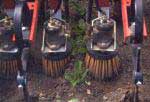 |
Weed control and transplanting techniques in row crops
Summary
The object of the project is to develop a growing technique by wich beets are transplanted in the field and mechanically cleaned of weed. The aim is to develop a growing technique, where weed control can be per-formed by rational mechanised methods. The purpose of the transplanting is to ensure the absence of germinated weed not bigger than the seed leaf stage when the beets are established, and they restrain mechanical weeding. Under these conditions it is possible to perform an effective weed control by using weed harrows or hoes equipped with tools for in-row weeding. In this way it should be possible to replace a large amount of manual work by rational mechanised processes. The in-row weeding is performed by weed har-rowing or by hoes equipped by in-row tools.
From the results it can be concluded, that it is possible to transplant beets under Danish soil and climate conditions in such a way, that it is possible afterwards to perform an effective mechanical weed control. There is seen problems concerning ramifications of the roots compared to what is seen for the seeded beets. This problem has been reduced during the research period by changing the geometry of the soil blocks, the transplanting procedure and the temperature procedure during the procedure of raising the seedlings, though the problem is not yet fully solved. To make the system interesting from a commercial point of view the costs has to be reduced compared to what is known from horticultural systems. One possibility is to sim-plify the system for raising the seedlings. To analyse these possibilities the research group has done a study tour to Finland in the spring 1999, here the systems for raising of the speedlings is decentrally organised on farm level, using simple polymer houses. The temperature control is performed by use of heaters of the same type as used for drying of grain in the harvest time.
|